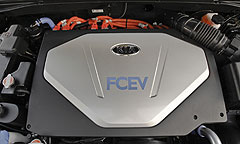Future models - Kia - Borrego - FCEVLA Show: Kia’s electric dream carHard cell: Kia’s new Borrego fuel cell vehicle has a range of some 685km. South Koreans introduce their latest hydrogen-fuelled electric test vehicle24 Nov 2008 KIA launched the latest phase of parent company Hyundai’s impressive Fuel Cell Electric Vehicle (FCEV) program at the Los Angeles International Auto Show last week. A new hydrogen-fuelled FCEV was unveiled, based on the all-new Borrego SUV first presented at the Detroit show earlier this year, and Kia says the vehicle represents a major technological step forward. Kia claims that numerous innovations give the Borrego FCEV higher performance, a greatly extended driving range and cold-weather starting capability to operate in sub-zero temperatures. These innovations include a new 450-volt supercapacitor instead of a lithium-ion polymer battery and a higher output 115kW fuel cell, which is 44 per cent more powerful than the 80kW unit in the company’s earlier environmental technology showcase model, the Sportage FCEV. This gives the Borrego FCEV a 161km/h top speed (compared with 150km/h for the Sportage FCEV) and a 0-100km/h acceleration time of 12.8 seconds (against 15.0s).  left: FCEV engine. left: FCEV engine.More importantly, Kia claims that the Borrego FCEV with a 202-litre hydrogen tank has a maximum range of 685km whereas the battery-equipped Sportage FCEV with a 152-litre tank could only make 300km. The Borrego FCEV’s powerplant and is located under the floor in the centre of the vehicle while the hydrogen tank, which is pressured to 70MPa, is located under the vehicle and ahead of the rear wheels. Hyundai-Kia Automotive Group’s president of research and development, Hyun Soon Lee, claims “a best-in-class system efficiency of 62 percent” for his latest fuel cell vehicle and said the company is keen to demonstrate its ability to conduct engineering of both petrol/diesel production models and fuel cell research vehicles simultaneously. “Entering this new phase of our program is really exciting,” said Dr Lee. “Now we will be able to build fuel cell electric vehicles in higher volumes and lower cost for fleet testing and the latest Borrego FCEV drives us closer to making fuel cell vehicles available for consumers.” Hyundai and Kia told GoAuto 12 months ago – when we drove the Sportage FCEV – that it hopes to have fuel cell technology ready for commercial application in vehicles under both brands by 2012. Dr Lee said that the Borrego FCEV uses lightweight aluminum body shell components and has a power-to-weight ratio that is similar to the production model SUV, while retaining retains the cabin space, low noise levels and overall driving refinement of the petrol and diesel-powered versions. HMC’s fuel cell program received a major boost last year when Hyundai’s second-generation Tucson FCEV (on which the Kia Sportage FCEV was based) beat some high-profile rivals from car-makers such as Daimler, General Motors and Nissan at the 2007 Bibendum Challenge sustainable mobility competition in China. The South Korean car-maker has been quietly working away on its program since 2000, when it purchased fuel cell stack technology from US-based UTC Technology. It is also working on the introduction of its own hybrid vehicles, including a ground-breaking model that uses LPG instead of petrol or diesel. Read more:Gas the battery, says HEVy HyundaiLPG hybrid bid First Drive: Hyundai-Kia fires on fuel cell front Hyundai's fuel cell rethink Borrego boned as Kia searches Soul First look: Kia goes Borrego All future models Alfa Romeo Alfa Romeo Abarth Abarth Alpine Alpine Alpina Alpina Audi Audi Aston Martin Aston Martin BMW BMW Bentley Bentley Chery Chery Brabham Brabham Chrysler Chrysler Chevrolet Chevrolet Cupra Cupra Citroen Citroen DS DS Dodge Dodge Fiat Fiat Ferrari Ferrari Foton Foton Ford Ford Great Wall Great Wall FPV FPV Haval Haval GWM GWM Honda Honda Holden Holden Hummer Hummer HSV HSV Infiniti Infiniti Hyundai Hyundai Jaguar Jaguar Isuzu Isuzu Kia Kia Jeep Jeep Land Rover Land Rover Lamborghini Lamborghini Lexus Lexus LDV LDV Mahindra Mahindra Lotus Lotus Mazda Mazda Maserati Maserati Mercedes-AMG Mercedes-AMG McLaren McLaren MG MG Mercedes-Benz Mercedes-Benz Mitsubishi Mitsubishi Mini Mini Opel Opel Nissan Nissan Peugeot Peugeot Pagani Pagani Proton Proton Porsche Porsche Renault Renault Ram Ram Rover Rover Rolls-Royce Rolls-Royce Skoda Skoda Saab Saab SsangYong SsangYong Smart Smart Suzuki Suzuki Subaru Subaru Toyota Toyota Tesla Tesla Volvo VolvoMotor industry news |
Click to shareKia modelsResearch Kia All future models Alfa Romeo Alfa Romeo Abarth Abarth Alpine Alpine Alpina Alpina Audi Audi Aston Martin Aston Martin BMW BMW Bentley Bentley Chery Chery Brabham Brabham Chrysler Chrysler Chevrolet Chevrolet Cupra Cupra Citroen Citroen DS DS Dodge Dodge Fiat Fiat Ferrari Ferrari Foton Foton Ford Ford Great Wall Great Wall FPV FPV Haval Haval GWM GWM Honda Honda Holden Holden Hummer Hummer HSV HSV Infiniti Infiniti Hyundai Hyundai Jaguar Jaguar Isuzu Isuzu Kia Kia Jeep Jeep Land Rover Land Rover Lamborghini Lamborghini Lexus Lexus LDV LDV Mahindra Mahindra Lotus Lotus Mazda Mazda Maserati Maserati Mercedes-AMG Mercedes-AMG McLaren McLaren MG MG Mercedes-Benz Mercedes-Benz Mitsubishi Mitsubishi Mini Mini Opel Opel Nissan Nissan Peugeot Peugeot Pagani Pagani Proton Proton Porsche Porsche Renault Renault Ram Ram Rover Rover Rolls-Royce Rolls-Royce Skoda Skoda Saab Saab SsangYong SsangYong Smart Smart Suzuki Suzuki Subaru Subaru Toyota Toyota Tesla Tesla Volvo VolvoMotor industry news |














Facebook Twitter Instagram